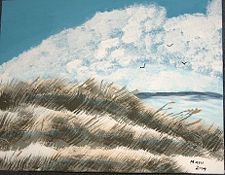Painting: Difference between revisions
imported>Howard C. Berkowitz |
mNo edit summary |
||
| (One intermediate revision by one other user not shown) | |||
| Line 12: | Line 12: | ||
From the standpoint of components, they divide into the coloring and the adhesive base. | From the standpoint of components, they divide into the coloring and the adhesive base. | ||
===Coloring=== | ===Coloring=== | ||
{{Image|Cropped Ocean Front.jpg|left|225px|Decorative painting on canvas board. The painting pattern was traced from the book Little Landscapes by Priscilla Hauser. The painting was done in acrylic.}} | |||
Broadly, these divide into finely ground pigments, or soluble dyes. Many [[paint pigment]]s go back into antiquity, although some are modern synthetics. | Broadly, these divide into finely ground pigments, or soluble dyes. Many [[paint pigment]]s go back into antiquity, although some are modern synthetics. | ||
| Line 29: | Line 31: | ||
==Tools== | ==Tools== | ||
There are a vast number of devices that can apply paint. Industrially, there are paint rollers, spray guns, brushes, foams, and pads. Artistically, there are brushes made from either natural or synthetic materials: horse hair is a popular brush material, nylon is often regarded as a "cheap" material. | There are a vast number of devices that can apply paint. Industrially, there are paint rollers, spray guns, brushes, foams, and pads. Artistically, there are brushes made from either natural or synthetic materials: horse hair is a popular brush material, nylon is often regarded as a "cheap" material.[[Category:Suggestion Bot Tag]] | ||
Latest revision as of 16:01, 30 September 2024
Painting is a visual art form that involves applying paint to a medium, such as paper or a canvas, in such a way that it communicates emotion, expression, or an idea. Alternatively, it may be a task that just involves applying paint to walls in order to change the interior decoration of a room.
History
The fundamental idea of creating a picture to convey an idea goes back to the dawn of mankind, when prehistoric man would illustrate something about the events of the day or about the way he felt. There are caves around the world which are preserved that give us an insight to the early artistic applications of early man.
Medium
There are many different types of paints, regardless of the way they are used. From the standpoint of components, they divide into the coloring and the adhesive base.
Coloring
Broadly, these divide into finely ground pigments, or soluble dyes. Many paint pigments go back into antiquity, although some are modern synthetics.
Bases
Environmental protection requirements have reduced the number of bases that have a volatile organic chemical as a solvent. Still, there are "oil" bases for both commercial and artistic use. There are specialized bases such as plastics and epoxy resins.
Water-soluble bases include latex, acrylic, and various gums used for water color.
Both in industry and art (e.g., pastel), some paints are applied as dry powders.
Style
Throughout the various phases of history, different painting styles(methods) were introduced. These styles can be indicative of the various artists' expressions of their perspective of the times they lived in--different styles developed at certain times often because the artist was looking to make a point about society that may have been unique to them, and was not the status quo.
Other styles of painting came about through advancements in mathematics and scientific thought; many of Leonardo DaVinci's paintings have distinct mathematical implications, particularly the golden ratio.
Tools
There are a vast number of devices that can apply paint. Industrially, there are paint rollers, spray guns, brushes, foams, and pads. Artistically, there are brushes made from either natural or synthetic materials: horse hair is a popular brush material, nylon is often regarded as a "cheap" material.
